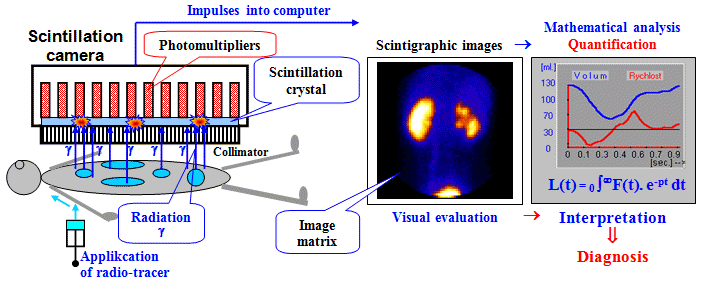NUCLEAR MEDICINE
What
is nuclear medicine?
Methods based on the
use of ionizing radiation and radioactivity have penetrated many
areas of science and technology, medicine and industry. In
medicine, in addition to the oldest and most widespread X-ray
diagnostics , radiotherapy is also used . From the 1950s. Open
radioactive substances applied to the body began to be used for
medical purposes - nuclear medicine was created
.
| Nuclear medicine is a field dealing
with diagnostics and therapy using radioactive isotopes
in open form, applied to the internal environment of the
organism. |
In vivo
diagnostics
In radionuclide diagnostics in
vivo in nuclear medicine, the patient is administered
(usually intravenously, sometimes orally or by inhalation) a
small amount of a suitable g-
radioactive
substance - the so-called radiondicator or radiopharmaceutical
. The radioindicator used is specific to individual organs and
types of examinations. The applied radioactive substance enters
the metabolism of the organism and is distributed there
according to its chemical composition - physiologically or
pathologically it accumulates in certain organs and their parts
and is subsequently excreted or regrouped. Gamma radiation
emanates from the deposition sites of the radio indicator which,
due to its penetration, passes through the tissue out of the
body. Using sensitive detectors, we measure this radiation g and
thus determine the distribution of the radiondicator in
individual organs and structures inside the body.
Scintigraphy
The most perfect devices of this type are gamma cameras
(scintillation cameras) - with the help of them we display the
distribution of a radio indicator in the organism in g radiation
. This method, called scintigraphy or gammagraphy
, makes it possible to obtain information not only anatomically,
but mainly about organ functions and metabolism. By mathematical
evaluation of scintigraphic studies, we can obtain time curves of
the radioindicator distribution and calculate dynamic parameters
characterizing the function of the relevant organs.

Schematic representation of the entire
process of scintigraphic examination - from the application of a
radio indicator to the patient, through the process of
scintigraphic imaging with a gamma camera, evaluation,
mathematical analysis and quantification, to the interpretation
and diagnosis.
The SPECT
(Single Photon Emission Copied Computerized Tomography) gamma
camera slowly rotates around the
patient's body, scans scintigraphic images from various angles
and then uses computer reconstruction to create cross-sectional
images (sections perpendicular to the camera's axis of
rotation), from which computer graphics can be used to construct spatial
(3-dimensional) images of the distribution of the radio indicator
in the organs inside the body.
The PET gamma camera
(Positron Computerized Tomography) detects photons of
gamma annihilation radiation (511 keV energy)
flying in opposite directions during the annihilation of
positrons emitted by a b + radio indicator applied to a
patient. These photons of annihilation radiation are coincidentally
detected by an annular scintillation detector, and by computer
reconstruction of the line projections of the coincidence sites,
images of cross sections and, if necessary, are generated. 3D
images similar to SPECT.
Nuclear medicine provides specific
methods for the examination of virtually all organs and thus
cooperates with a wide range of clinical disciplines. The most
widespread use is mainly in cardiology , nephrology
, neurology , oncology , thyrology,
gastroenterology .
Nuclear medicine methods are among
the least burdensome non-invasive diagnostic examination
methods. Due to the high sensitivity of the detectors, only a
very small amount of radiopharmaceutical is applied to the
patient, which is needed to obtain quality image information. The
radiation exposure in methods in nuclear medicine is comparable
(and often smaller) as in X-ray examinations.
Radionuclide
scintigraphy is described in detail in Chapter 4 " Radioisotope Scintigraphy " of the book " Nuclear Physics
and Ionizing Radiation Physics ".
In vitro
diagnostics
In nuclear medicine, in vitro
radioisotope diagnostic methods are also performed ,
where (non-radioactive) samples taken from patients are analyzed
using radiochemical as well as biochemical techniques using
radioisotopes. Most often it is a radioimmunoassay (RIA) or
radiosaturation analysis, which is used to highly sensitive
determination of the concentration of complex biological
substances in the blood serum - hormones, tumor markers and other
biologically important substances (it is briefly described in §3.5 " Radioisotope
tracking methods
", section " Diagnostics in vitro.
Radioimmunoassay ") .
Radioisotope
therapy
Nuclear medicine also includes therapy
with beta and alpha radionuclides, eg in the treatment of
hyperthyroidism or thyroid cancer, blood diseases, palliative and
curative therapy of tumors (and metastases), joint diseases.
A more detailed
description of radionuclide therapy is given in the section
" Radioisotope
therapy " in
Chapter 3 " Applications of ionizing radiation " of the book " Nuclear physics
and physics of ionizing radiation ".
Nuclear medicine -
interdisciplinary field of
nuclear medicine is due to the physical nature of its methods
and instrumentation used branch interdisciplinary . In
addition to physicians (specialized and certified in the
field of nuclear medicine), health. nurses and laboratory
technicians, are working in teamwork as well as experts
from other professions - physicist , electronics , radiochemik
, pharmacist . Along with medical and physical-technical
aspects, considerable attention is also paid to the radiation
protection of workers and patients in the workplaces of
nuclear medicine when working with radioisotopes .
Detailed
description of principles, methods and applications of nuclear
medicine + nuclear physics:
RNDr.
Vojtech Ullmann
